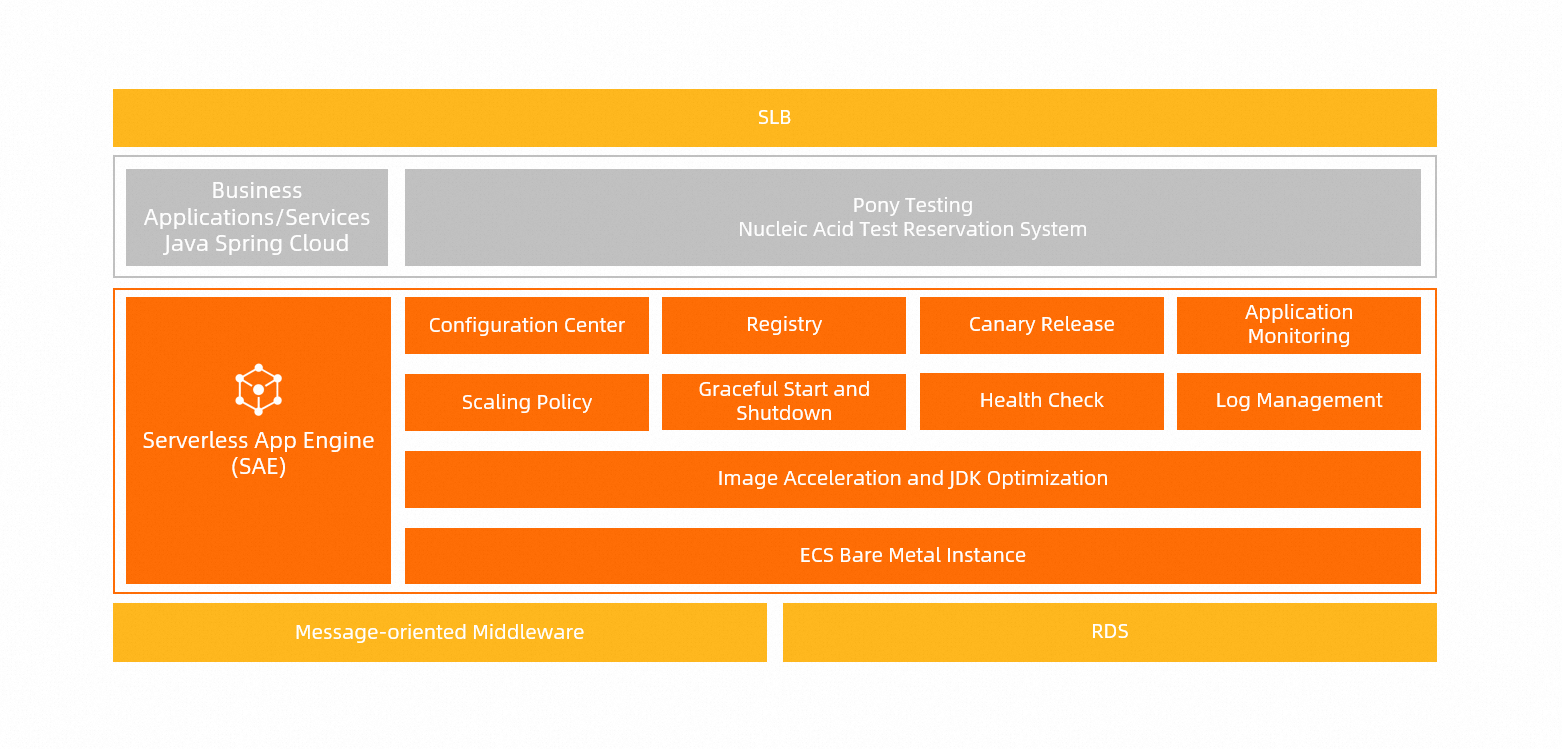Nucleic acid testing plays a key role in COVID-19 prevention. Beijing Pony Medical Laboratory Co., Ltd. (hereinafter referred to as Beijing Pony) is one of the first COVID-19 nucleic acid testing agencies in Beijing. The pandemic challenged the stability and availability of the nucleic acid test reservation system of Pony Testing. This topic describes how SAE helps Pony Testing perform stable cloud migration and fight against the COVID-19 pandemic.
Background information
Founded in 2002, Pony Testing International Group (hereinafter referred to as Pony Testing) has grown into a large, comprehensive testing and certification group with more than 6,000 employees, nearly 30 experimental bases, and 100 subsidiaries and branches throughout China. Pony Testing is a certified biomedical engineering laboratory in Beijing, an engineering technology research center recognized by the Beijing Municipal Science & Technology Commission, and an enterprise technology center recognized by the Beijing Municipal Commission of Economy and Information Technology.
On April 15, 2020, Beijing Pony, a wholly-owned subsidiary of Pony Testing, undertook the COVID-19 nucleic acid testing for Beijing. Pony Testing worked with Alibaba Cloud Serverless App Engine (SAE) to fight against the pandemic.
Challenges
The nucleic acid test reservation system of Pony Testing must handle business peaks due to the recurrent outbreaks of COVID-19. The following table describes the challenges faced by Pony Testing. The table also describes the benefits of SAE.
Challenge | Benefit |
High O&M costs: To handle business peaks, tedious and repetitive operations such as capacity estimation, environment preparation, and application deployment must be performed in advance. | SAE is a maintenance-free service that supports the Java microservices architecture. SAE allows you to focus on business without the need to manage the underlying infrastructure of microservices. This reduces costs and improves efficiency. |
Insufficient capacity to handle business peaks: In most cases, Pony Testing must deploy temporary applications to deal with unexpected traffic spikes. The time-consuming deployment process affects user experience. | SAE allows you to manually scale in and scale out instances, configure auto scaling policies, and configure rules for scheduled application start and stop. SAE supports the following types of auto scaling policies: scheduled auto scaling policy, metric-based auto scaling policy, and hybrid auto scaling policy. SAE provides a second-level scaling capability and helps reduce hardware costs. |
High risks in version iteration: An integrated solution for system release and version iteration is required. Each time a version is released, Pony Testing must configure complex settings. The stability of the system after the version is released cannot be ensured. | SAE can ensure the stability of business applications. After you create an application, you can configure a release policy based on your business requirements to iteratively upgrade the application. If issues exist in an upgraded version, you can roll back the application to an earlier version with a few clicks. SAE provides the health check and graceful start and shutdown features to improve the efficiency of version iteration. SAE also provides application monitoring and diagnostics capabilities. You can efficiently identify and resolve issues that are related to version release in the SAE console. |
Solution
The following figure shows the solution that is used by Pony Testing. 
To improve system efficiency, Pony Testing uses SAE to quickly build a platform that provides lifecycle management and microservices governance capabilities for Java Spring Cloud applications. Pony Testing does not need additional resources or costs to build supporting components. By leveraging the high scalability and flexible auto scaling policies of SAE, Pony Testing can build an efficient and stable mechanism and architecture to handle unexpected traffic peaks during nucleic acid test reservation. SAE can automatically scale out or scale in service instances based on business traffic. The entire process is imperceptible to users and does not require manual intervention. SAE provides the built-in application performance monitoring (APM) capability to help Pony Testing analyze the health status of applications based on vertical metrics and horizontal links. SAE provides the health check and graceful start and shutdown features to allow Pony Testing to release applications during the day. SAE helps Pony Testing improve the efficiency of O&M message pushing and version iteration and ensures the stability of business applications.
Effect
SAE provides high scalability and flexible auto scaling policies, and the application lifecycle management capability. The preceding capabilities help Pony Testing improve O&M and R&D efficiency and allow the nucleic acid test reservation system to handle daily business peaks with high stability.
Quick construction of a robust core system: SAE is an integrated service that provides various capabilities to help Pony Testing develop and construct a stable and reliable system in a short period of time.
Improved O&M efficiency and lower O&M costs: The SAE elastic policy solution allows Pony Testing to efficiently handle periodic business peaks by using the auto scaling policies of SAE. Pony Testing no longer needs to evaluate resource usage or deploy applications. This significantly reduces the workloads of the O&M team.
Efficient handling of business peaks: SAE provides high scalability, which allows Pony Testing to handle business traffic spikes without the need to temporarily deploy applications. This significantly improves user experience.
Real-time monitoring of the health status of business applications: The lifecycle management and microservices governance capabilities of SAE help Pony Testing shorten the release cycle and increase the stability of version iteration. Pony Testing can quickly identify the bottlenecks of application performance and configure optimization policies.
 Elastic Compute Service (ECS)
Elastic Compute Service (ECS)
 Container Compute Service (ACS)
Container Compute Service (ACS)




























